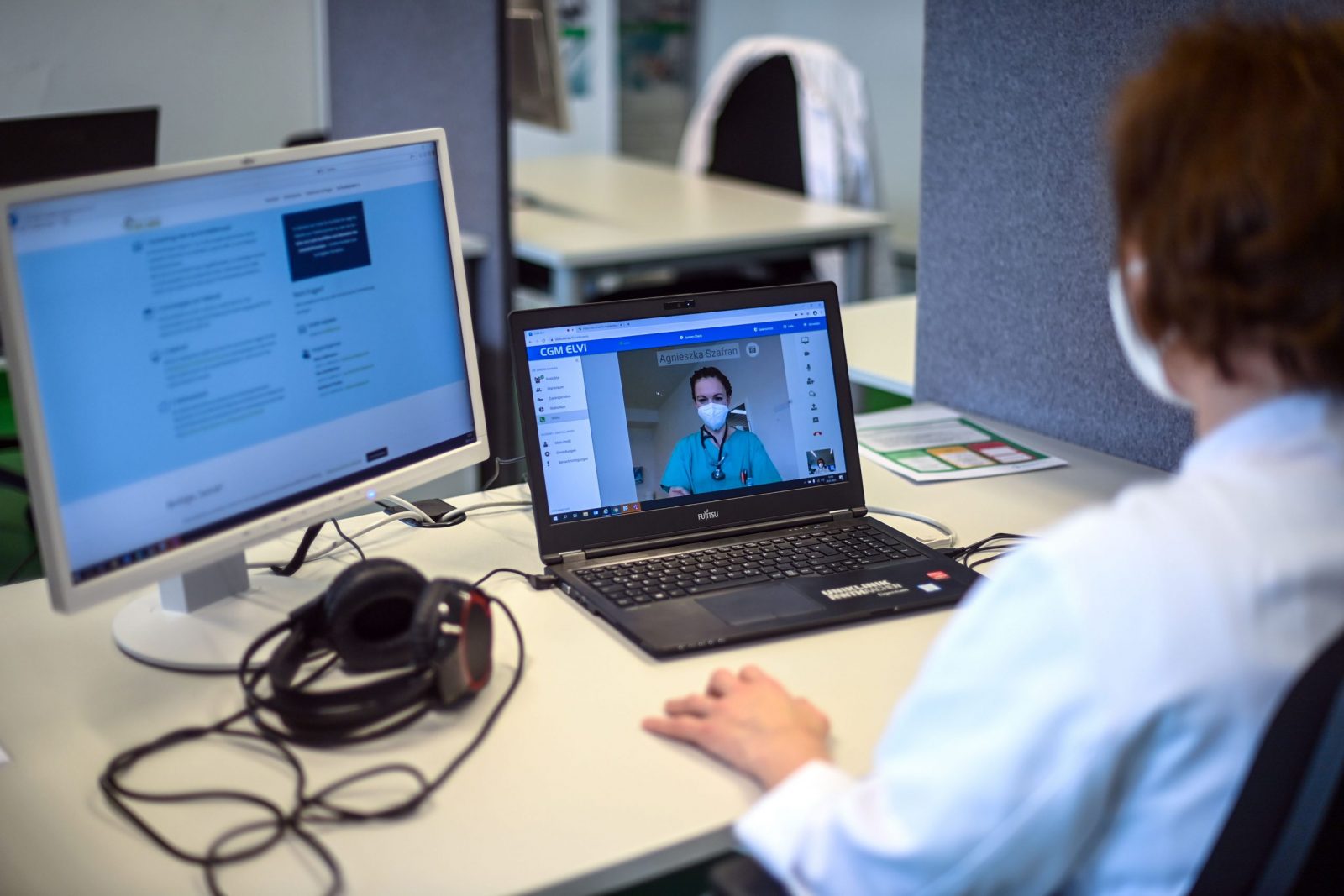Get Ready for the Post-Pandemic Health Care Talent Revolution

A physician uses telemedicine to treat COVID-19 patients in Germany.
Photo: Ina Fassbender/AFP via Getty Images
The adoption of remote work in the health care industry had trailed other industries. Now, as some health care companies begin bouncing back after going fully remote in response to the pandemic, they’re becoming more employee-centric regarding work location and improving employee experience.
But what will health care’s future workforce look like? How can more leaders’ decisions balance employees’ and companies’ best interests? When we asked chief medical officers, chief human resources officers, and chief financial officers at a number of health care companies, we discovered that the conditions for an all-out talent war are here.
Most health care organizations expect to continue with remote work and are increasingly comfortable sourcing that talent from anywhere — in the U.S. or abroad. While this was long true for national organizations, regional players are joining the fray. Fifty percent of organizations say they are changing their hiring policies to source talent — and importantly, let talent stay — outside of their typical geographic footprint. That means talent is that much more mobile — not a privilege of concentrated geographic talent pools.
The Pandemic Caused a Notable Shift Toward Remote Work
Top Factors Providers and Payers Consider Regarding the Future
Three Things to Know
The rapid shift to remote work was generally smoother than many executive teams anticipated. Although announcements of remote and flex working have been fast and furious in the technology industry, in health care, they were somewhat quieter. To learn more, we fielded a survey. Here, we confirmed health care companies are eyeing a permanent shift to more flexible work.
- All — 100% — of companies surveyed said they were either considering or already announced changes to their working model. Those changes showed a strong shift to a more flexible and remote working model.
- All — 100% — of the providers we surveyed had already announced their future work model, versus only 60% of payers and innovators, such as those in retail and tech. This is not surprising, given the pressure on providers in 2020 to adapt.
- There’s a disconnect. Employee-centricity and employee choice was the most-cited reason for making workforce changes, but only 40% of companies said they were including employee input in which future work model they would implement.
One-Third of Organizations Have Announced Their Post-Pandemic Approach. One-Fourth Have Returned to the Office
Managing a workforce that deploys a mix of work-from-home, onsite and hybrid models can be done right, but doing so requires new ways of managing talent, cultivating culture and enabling teams with tools to work productively. New forms of technological offerings mean the virtual office is mainstream, and the future of work will be different. But the right workforce model is different for each company. What does your ideal workforce breakdown look like?
What Does the Future of Work Look Like?: Four Common Work Models
Employer Blind Spots
While the future of work carries the promise of flexibility, not all leaders or employees will embrace change. Leaders must take a nuanced approach, segmenting the workforce to determine the right model for different job categories, roles and for the overall culture and future way of working. We see a major blind spot in this area right now. Employers are being short-sighted in moving to a flexible model, without incorporating employee input on what flexibility they would like. While that optimizes for the short-term, it comes at the risk of employee turnover.
Employee Input Was Not a Priority When Rebuliding Working Arrangements
Those who take a top-down approach versus doing the hard work to balance company preference with employee input will dictate the net talent winners — versus those that end up alienating their employees with flexibility that exists only on paper.
Designing Your Future Workforce
Designing a fit-for-future workforce model requires re-thinking organization dynamics.
Don’t Ignore Employee Engagement and Cultural Development
When you peel back the “culture” onion, you may see sub-categories emerge, like personal connections, principles, management expectations, workforce norms and leaders’ actions and behaviors. In a hybrid environment, with some employees in person and some virtual, there will be less opportunity for daily connections and observed leadership norms that must be addressed early in the process.
Think about what your organization might hold dear and true, for example, if your workplace is metric-oriented versus highly analytical, conservative versus one where people bring their whole selves to work, and how you reinforce, change or leave behind cultural touchstones in your new model. Thoughtfully engage employees with messages that go beyond the transactional and involve them in helping define the future culture — thereby creating a culture “community.”
Culture was built around how you used to work. How will you bring elements of that culture through this transition without losing it?
Career Path Management Requires Networking and Collaborating Differently
Historically speaking, work that’s typically performed remotely has been more transactional. Picture, for example, a call center representative with a given target to meet. Health care organizations are already experienced with these kinds of workers. We see a second blind spot in not thinking about how you develop more collaborative working arrangements that replicate the quick “hallway touchpoints,” impromptu watercooler brainstorms and real apprenticeships of the prior working model. Health care organizations have the most work to do here — compared to banking and other industries — in defining the new path for cross-functional roles in the context of a hybrid work environment.
Get Creative With Productivity Management
In terms of workplace productivity, employee engagement and operational excellence, creativity must be a common thread. As more workers go remote, think differently about how to optimize workers’ performance levels. Consider where new metrics and supports are needed most to create the most effective and engaged workforce possible. Collecting and tracking metrics is also imperative for informed future decision-making.
Reconsider Your Real Estate
Many companies have hard real estate targets in place, such as a 50% reduction in the next few years — meaning more permanence and less flexibility may follow. As organizations think about their workforce, they will face important real estate questions — namely: Do we really need all this space?
We tend to find that organizations that approach this question through a real estate-first orientation generally aren’t thinking about how to optimize the organization for success long-term. We recommend instead focusing on developing the right workforce strategy for your organization’s success going forward. And, considering how to update space for the new kinds of working with as much attention as footprint reductions, such as repurposing into showrooms, collaboration spaces, community connection hubs. Surprisingly, focusing first on talent and employee working needs often leads to larger real-estate reductions than a real estate-first approach.
Prioritize Talent
Give employees some input into the future of your work model. Focusing simply on average employee preferences toward remote work will miss the edge cases of those with valid needs or preferences for a different working model. Taking into account manager, team and employee preferences will be a huge factor in the war for talent in the future as well as productivity and engagement. Companies that short-cut this opportunity to balance employee input with company preference will find themselves losing the health care talent war.
Final Thoughts
Ultimately, more change is coming. The bid for talent will only increase as health care companies are expected to continue making changes in their working model throughout the next 12 to 18 months. Don’t be left behind in creating an environment your employees want to be in. This is the challenge ahead of all health care companies — to capture opportunity, you must capture talent.












